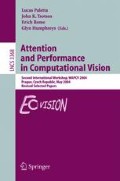Abstract
We propose a new biologically motivated model to localize or detect faces in natural color input scene. The proposed model integrates a bottom-up selective attention model and a top-down perception model. The bottom-up selective attention model using low level features sequentially selects a candidate area which is preferentially searched for face detection. The top-down perception model consists of a face spatial invariant feature detection model using ratio template matching method with training mechanism and a face color perception model, which is to model the roles of the inferior temporal areas and the V4 area, respectively. Finally, we construct a new face detection model by integration of the bottom-up saliency map model, the face color perception model and the face spatial invariant feature detection model. Computer experimental results show that the proposed model successfully indicates faces in natural scenes.
Access this chapter
Tax calculation will be finalised at checkout
Purchases are for personal use only
Preview
Unable to display preview. Download preview PDF.
References
Itti, L., Koch, C., Niebur, E.: A model of saliency-based visual attention for rapid scene analysis. IEEE Trans. Patt. Anal. Mach. Intell. 20(11), 1254–1259 (1998)
Yang, M., Kriegman, D.J., Ahuja, N.: Detecting faces in images: a survey. IEEE Trans. Patt. Anal. Mach. Intell. 24(1), 34–58 (2002)
Walther, D., Itti, L., Riesenhuber, M., Poggio, T., Koch, C.: Attentional selection for object recognition – a gentle way. In: Bülthoff, H.H., Lee, S.-W., Poggio, T.A., Wallraven, C. (eds.) BMCV 2002. LNCS, vol. 2525, pp. 472–479. Springer, Heidelberg (2002)
Serre, T., Riesenhuber, M., Louie, J., Poggio, T.: On the role of object-specific features for real world object recognition in biological vision. In: Bülthoff, H.H., Lee, S.-W., Poggio, T.A., Wallraven, C. (eds.) BMCV 2002. LNCS, vol. 2525, pp. 387–397. Springer, Heidelberg (2002)
Barlow, H.B., Tolhust, D.J.: Why do you have edge detectors? Optical society of America Technical Digest 23, 172 (1992)
Bell, A.J., Sejnowski, T.J.: The independent components of natural scenes are edge filters. Vision Research 37, 3327–3338 (1997)
Park, S.J., An, K.H., Lee, M.: Saliency map model with adaptive masking based on independent component analysis. Neurocomputing 49, 417–422 (2002)
Guyton, A.C.: Textbook of medical physiology, 8th edn. W.B. Saunders company, USA (1991)
Majani, E., Erlanson, R., Abu-Mostafa, Y.: The eye. Academic, New York (1984)
Kuffler, S.W., Nicholls, J.G., Martin, J.G.: From Neuron to Brain. Sinauer Associates, Sunderland (1984)
Bruce Goldstein, E.: Sensation and Perception, 4th edn. An international Thomson publishing company, USA (1995)
Lee, T.W.: Independent Component Analysis-theory and application. Kluwer academic publisher, USA (1998)
Ratnaparkhi, A.: Maximum entropy models for natural language ambiguity resolution, Ph.D thesis from Computer and Information Science in the University of Pennsylvania (1998)
Bednar, J.A., Miikkulainen, R.: Self-organization of innate face preferences: Could genetics be expressed through learning? In: Proceeding of 17th National Conference on Artificial Intelligence, pp. 117–122 (2000)
Baek, J., Cho, S.: Time jump in?: long rising pattern detection in KOSPI200 future using an auto-associative neural network. In: proceeding of 8th International Conference on Neural Information Processing, Shanghai, China, November 14-18, pp. 160–165 (2001)
Sinha, P.: Qualitative representations for recognition. In: Bülthoff, H.H., Lee, S.-W., Poggio, T.A., Wallraven, C. (eds.) BMCV 2002. LNCS, vol. 2525, pp. 453–461. Springer, Heidelberg (2002)
McKennan, S., Gong, S., Raja, Y.: Modeling facial color and identity with Gaussian mixtures. Patten Recognition 31(12), 1883–1892 (1998)
Forsyth, M.: A novel approach to color constancy. International Journal of Computer Vision 5(1), 5–36 (1990)
Author information
Authors and Affiliations
Editor information
Editors and Affiliations
Rights and permissions
Copyright information
© 2005 Springer-Verlag Berlin Heidelberg
About this paper
Cite this paper
Ban, SW., Lee, M. (2005). Biologically Motivated Visual Selective Attention for Face Localization. In: Paletta, L., Tsotsos, J.K., Rome, E., Humphreys, G. (eds) Attention and Performance in Computational Vision. WAPCV 2004. Lecture Notes in Computer Science, vol 3368. Springer, Berlin, Heidelberg. https://doi.org/10.1007/978-3-540-30572-9_15
Download citation
DOI: https://doi.org/10.1007/978-3-540-30572-9_15
Publisher Name: Springer, Berlin, Heidelberg
Print ISBN: 978-3-540-24421-9
Online ISBN: 978-3-540-30572-9
eBook Packages: Computer ScienceComputer Science (R0)

